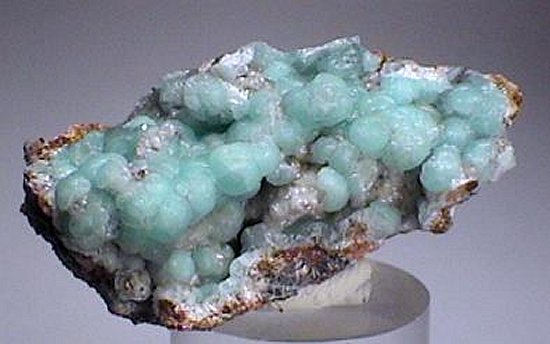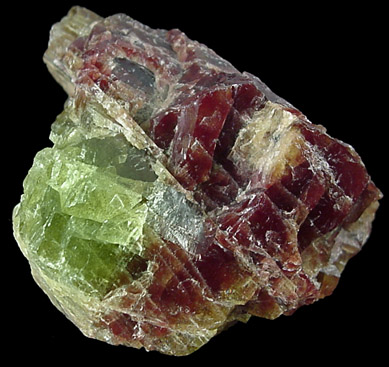Willemite
The mineral willemite, also known by its outdated, mining designation Belgit or as Hebertin or Villemit, is a relatively rare occurring silicate from the island Phenakitgruppe. It crystallizes in the trigonal crystal system with the chemical composition of Zn 2 [ SiO 4 ] and usually develops prismatic, tabular crystals, but also radial- granular aggregates of white, red or green-yellow color. Even colorless crystals are known.
Special Features
The outstanding property of willemite is its strong, bright green fluorescence under short-and long-wave UV light as well as electron beam irradiation. Therefore, it has been widely used as a phosphor for so-called magic eyes, a now obsolete optical display tube in radio technology. Note, however, that the intensity of fluorescence is subject to large variations depending on locality. To include the mineral finds from Franklin Hill and Sterling Hill, New Jersey offers the most powerful fluorescent. The metamorphosis of the (see also Section Education and localities ) unrecognized Willemite the so-called "iron hat ", however, show no fluorescence.
Willemite has a Mohs hardness of 5.5, and a density from 3.9 to 4.2 g/cm3. The translucent to opaque crystals show on the faces of resin to glass shine.
Etymology and history
Willemite was named in honor of William I (1772-1843, King of the Netherlands ) after this. Was first found in 1830 in the mineral Calamine ( formerly known as Altenberg and especially because of the local zinc mine and foundry Vieille Montagne ). , And described by Armand Lévy
Classification
According to the old ( 8th edition ) and new classification of minerals ( 9th Edition ) by Strunz heard the Willemite to the island silicates ( nesosilicates ). In the new system, this department has however been further subdivided and find the mineral now in the division of the island silicates without additional anions with cations in tetrahedraler coordination.
The classification of minerals according to Dana assigns the willemite also in the department of the island silicates. However, the sub-division is adjacent only the arrangement of the cations, which are arranged in co-ordination. In the Dana classification, the minerals willemite, eukryptite and Phenakit form the Phenakit group.
Modifications and varieties
Currently ( as of 2008), two varieties of willemite are known: The 25.4 % of cobalt (II ) oxide ( CoO ) enriched shouldered Xingshaoit and the manganese-containing troostite.
Education and Locations
Willemite is either formed as a secondary mineral in zinc deposits or through metamorphosis in marble. Accompanying minerals include cerussite, Duftit, Glaukochroit, hemimorphite Franklinite, malachite, Mimetite, Nasonit, Rosasit, Smithsonite and zincite.
Locations are in addition to its type locality La Calamine, you still San Luis in Argentina; South and Western Australia; the provinces of Liège and Limburg in Belgium; Hesse, Lower Saxony, North Rhine -Westphalia and Saxony in Germany; Liguria, Sardinia and Tuscany in Italy; Quebec, Newfoundland and Labrador in Canada; Katanga in the Democratic Republic of Congo; Grootfontein and Tsumeb in Namibia; Carinthia in Austria; Dalarna, Värmland Västmanland and in Sweden; and various regions in the United States.
Crystal structure
Willemite crystallizes in the trigonal crystal system in the space group with the lattice parameters a = 13.94 Å and c = 9.31 Å and 18 formula units per unit cell.










.jpg)